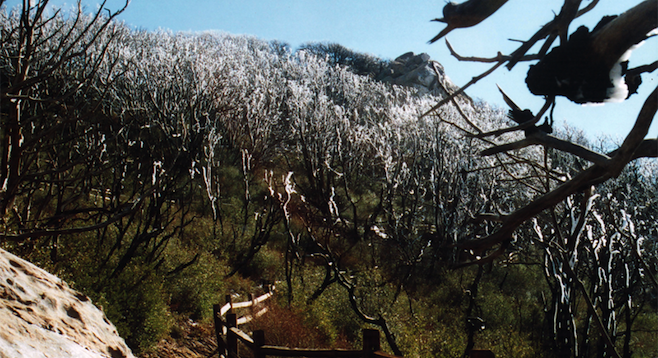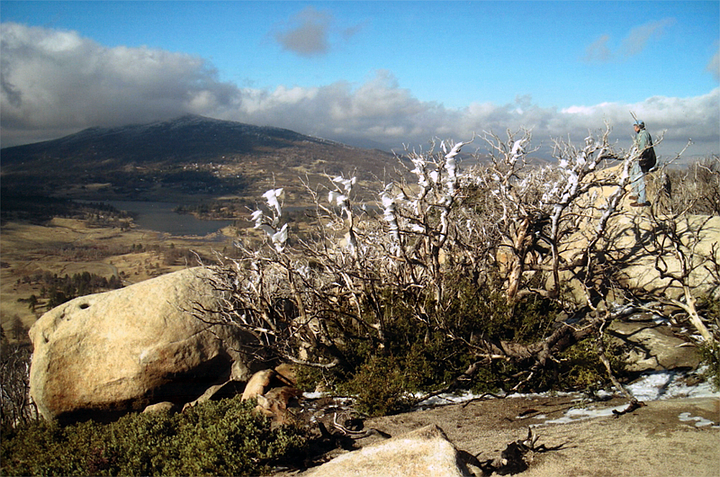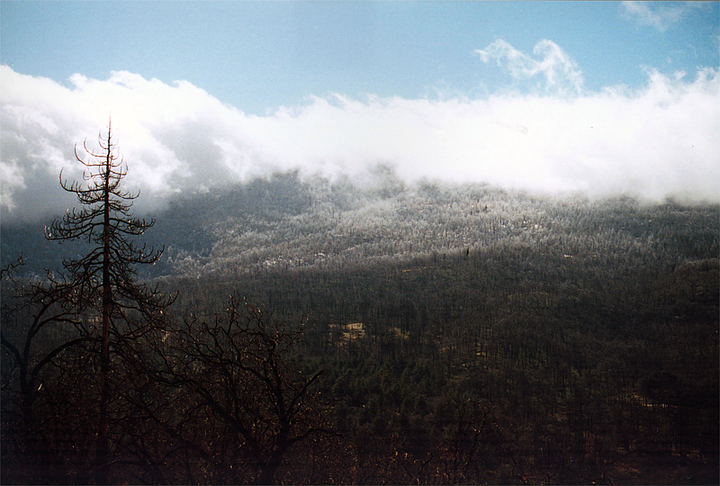 Facebook
Facebook
 X
X
 Instagram
Instagram
 TikTok
TikTok
 Youtube
Youtube

Somewhere in the Cuyamacas there’s a box canyon wide enough to include 50 armed men on horseback and tall enough to conceal at least 200 Kumeyaay warriors lying in wait around the rim. But try as we might Trusty, my trusty photographer, and I never found the spot.

For me, researching San Diego history starts on the ground: get a feel of the mesa where John J. Montgomery made his – and the world’s - first glider flight in 1883; walk the battlefield at San Pasqual; seek the Fountain of Youth allegedly across the way from Sweetwater Dam.
“Trusty” is Michael Clark. When not tramping through tick-infested shrubs or scaling slippery granite, he’s Senior Vice Provost for Academic Planning at UC Irvine. Among his duties: plan the University of California curriculum for the next 50 years. I like to get him out of the office – for equally hazardous duty.
Things happen that don’t make print. At the site of Montgomery’s flight a crisp, northwest wind whipped up the mesa and almost launched us off the edge. A seagull, hovering overhead squawked at our land-lubbing reaction. On Mule Hill, where Stephen Watts Kearney’s wounded troops almost starved, we watched the last third of a bull rattlesnake zigzag for cover between two rocks.
We have tracked down many a wonder, but we never found that box canyon.

In 1837, native tribes banded together. Their plan: murder every male Californio from the ranchos to the presidio. They would keep the women, wrote Augustin V. Zamorano, “to form a new race.”
The tribes began their assault in the spring. An estimated 150 to 200 attacked Rancho Jamul. They killed the men, torched the buildings, trampled the fields, and headed east with two young women. The going was slow because they herded all the livestock.
San Diegans hired “Macedonio”: Sergeant Macedonio Gonzalez. “A man of great courage,” writes Don Agustin Janssens, and great cruelty. After he tortured them, he often killed captives with a sword, to save bullets. “He tried to justify the motive of his conduct by saying it was the only way to keep the savages quiet.”
Macedonio went east with 50 men like Sherman through Georgia. He burned villages, raped and pillaged.
He eventually tracked the warriors to a box canyon. At the mouth, on both sides at the top, the two young women stood: their bodies painted white, their hair cropped short. When they tried to shout “ambush,” natives covered their mouths and yanked them away.

Macedonio led his force into the canyon. When all were inside, hundreds of arrows blotted the sky in a horseshoe pattern. Most were aimed at Macedonio. One cut through his lips and changed the way he spoke.
Horses went down. Riders scrambled to find another, or take cover beneath their fallen mount. As natives tried to seal off the entrance with boulders, Jatinil, a chief from Baja, arrived with 30 men and stopped the ambush. “But for this,” writes Janssens, “more than half of us, and perhaps more, would have fallen victims. Jatinil, the pagan, after God, was our salvation.”
At least 20 men were wounded, and flying stones pelted everyone with deep bruises. No source tallied native losses, or the dead.
The two young women, Tomasa and Ramona Leiva – said to be Macedonio’s nieces – were never found.
So okay. A box canyon wide enough to encompass Macdeonio’s force and obviously on one of the old, most traveled trails in the back country. Should narrow it down, you’d think.
Next time: Field Notes


Somewhere in the Cuyamacas there’s a box canyon wide enough to include 50 armed men on horseback and tall enough to conceal at least 200 Kumeyaay warriors lying in wait around the rim. But try as we might Trusty, my trusty photographer, and I never found the spot.

For me, researching San Diego history starts on the ground: get a feel of the mesa where John J. Montgomery made his – and the world’s - first glider flight in 1883; walk the battlefield at San Pasqual; seek the Fountain of Youth allegedly across the way from Sweetwater Dam.
“Trusty” is Michael Clark. When not tramping through tick-infested shrubs or scaling slippery granite, he’s Senior Vice Provost for Academic Planning at UC Irvine. Among his duties: plan the University of California curriculum for the next 50 years. I like to get him out of the office – for equally hazardous duty.
Things happen that don’t make print. At the site of Montgomery’s flight a crisp, northwest wind whipped up the mesa and almost launched us off the edge. A seagull, hovering overhead squawked at our land-lubbing reaction. On Mule Hill, where Stephen Watts Kearney’s wounded troops almost starved, we watched the last third of a bull rattlesnake zigzag for cover between two rocks.
We have tracked down many a wonder, but we never found that box canyon.

In 1837, native tribes banded together. Their plan: murder every male Californio from the ranchos to the presidio. They would keep the women, wrote Augustin V. Zamorano, “to form a new race.”
The tribes began their assault in the spring. An estimated 150 to 200 attacked Rancho Jamul. They killed the men, torched the buildings, trampled the fields, and headed east with two young women. The going was slow because they herded all the livestock.
San Diegans hired “Macedonio”: Sergeant Macedonio Gonzalez. “A man of great courage,” writes Don Agustin Janssens, and great cruelty. After he tortured them, he often killed captives with a sword, to save bullets. “He tried to justify the motive of his conduct by saying it was the only way to keep the savages quiet.”
Macedonio went east with 50 men like Sherman through Georgia. He burned villages, raped and pillaged.
He eventually tracked the warriors to a box canyon. At the mouth, on both sides at the top, the two young women stood: their bodies painted white, their hair cropped short. When they tried to shout “ambush,” natives covered their mouths and yanked them away.

Macedonio led his force into the canyon. When all were inside, hundreds of arrows blotted the sky in a horseshoe pattern. Most were aimed at Macedonio. One cut through his lips and changed the way he spoke.
Horses went down. Riders scrambled to find another, or take cover beneath their fallen mount. As natives tried to seal off the entrance with boulders, Jatinil, a chief from Baja, arrived with 30 men and stopped the ambush. “But for this,” writes Janssens, “more than half of us, and perhaps more, would have fallen victims. Jatinil, the pagan, after God, was our salvation.”
At least 20 men were wounded, and flying stones pelted everyone with deep bruises. No source tallied native losses, or the dead.
The two young women, Tomasa and Ramona Leiva – said to be Macedonio’s nieces – were never found.
So okay. A box canyon wide enough to encompass Macdeonio’s force and obviously on one of the old, most traveled trails in the back country. Should narrow it down, you’d think.
Next time: Field Notes
Comments